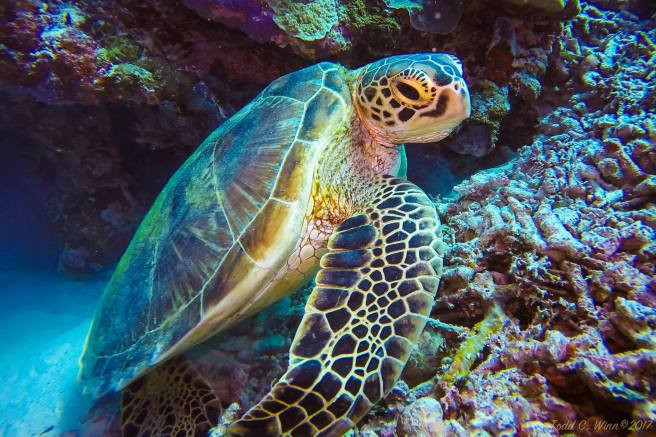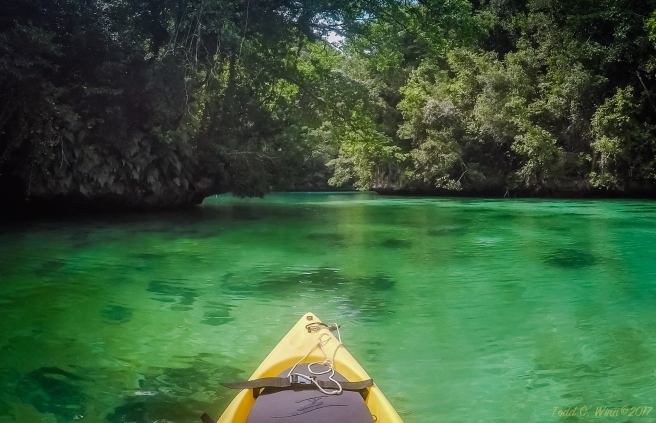
You want pristine waters, rich WWII history and the most amazing underwater rock walls you have ever seen? Yup, Palau has it all. Not only that, but it is also working to preserve its natural resources at a refreshing (but expensive) rate.
There are many options for exploring this gorgeous island. From kayaking in the rock islands to a walking WWII tour of the Battle of Paleliu, snorkeling in Jelly Fish lake and of course, world class diving. Unlike some of the neighboring Micronesian islands, Palau is absolutely for the outdoor adventurer, not just the diver.

Pictured: Kayaking in the rock islands where you can easily hop off snorkel among beautiful coral and then hop back in for some more
GETTING THERE
As with most of Micronesia, it is not easily accessible from the mainland US. Your central hubs are from Manila ($400 roundtrip, ~3 hours), Guam ($1000, 2hrs), Taipei ($400, 4hrs) and Seoul ($600, 5hrs). I flew direct from Guam while living there and did a tour package through my local dive shop (MDA). If you have time, I would recommend stopping off in Guam to get over jetlag then going through either MDA or AXE MURDERS – the two big dive shops on the island. Though, this is certainly not the cheapest route airfare-wise.
WHERE TO STAY
Palau has 340 islands in its stretch of the Carolina island chain; most major hotels, restaurants and dive companies operate out of the capital, Koror (also the airport) .
We stayed at Palau Central Hotel. Not a bad location or price (about a 15 min drive to the dive shop), though under construction while were there. Unlike Chuuk which is limited to 3 hotels on the island, Palau has plenty of options from high class resorts to inexpensive B&Bs (see here for good overview).
Liveaboards are also a great option to pack in as many dives as possible. Most avid divers coming out of Guam did Palau twice while living there, once on land and a second time on a liveaboard.

Most divers can tell you when they decided they really got this diving thing. For me, I had a moment on the 200+ foot Peleliu Wall looking out at the expanse of coral, marine life and sheer calm when I just thought – wow. Walls are my thing.
Whether you choose to do a liveaboard or stay on the island, 4 days is the minimum you want to spend here. On your fly days, Kayaking the Rock islands and snorkeling Jellyfish lake are both musts. We chose to go over Thanksgiving weekend and even had an epic Thanksgiving meal right on the water with our fellow dive crew. Our specific itinerary we followed is here. Though there are many dive companies on the island, we had a great time with Fish’n Fins
A NOTE ON PERMITS AND FEES
Palau is pretty pricey to get to and dive. Beware that you also will have a number of permit fees to pay for entrance to their top spots.
Required for all persons ages 6 & up. Valid for 10 days.
- Koror State permit w/ access to Jellyfish Lake – $100
- Koror State Permit, no JFL – $50.00. Add JFL later: $75
- Peleliu Diving permit: $30
- Other Peleliu water use: $15
- Land tour permit: $10
LANDSIDE – Peleliu
Many Americans forget that we fought a war on two fronts in WWII, one in Europe and one in the Pacific (see how this plays into the history of Guam and Chuuk). Japanese forces spread out over the Pacific islands making much of these tropical paradise’s prime targets for US-Japanese battles. What should have been a 4 day take over of the small island of Peleliu took over two months in a costly battle for both sides.
One of the key books written on this battle is With the Old Breed: Peleliu and Okinawa by Eugene Sledge, a later University professor and marine with the 1st Marine Division in WWII. We took a walking tour of the island and hit the Peleliu Wall dive site in one epic day. Tours and dives are easily arranged through your dive shop (Fish’n Fins).
Funny how things go — My husband, an avid WWII buff, had read the book years prior to us even meeting. The most memorable part about getting a walking tour on the island of Peleliu? Him going “If you had told me I would one day be on the island of Peleliu 5 years ago, I would have never believed it.”
I couldn’t believe it either. Happy exploring!












